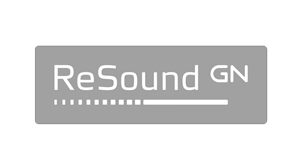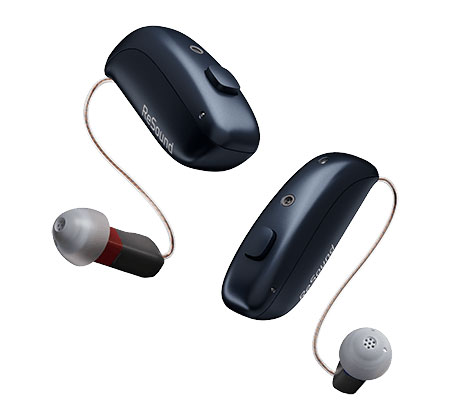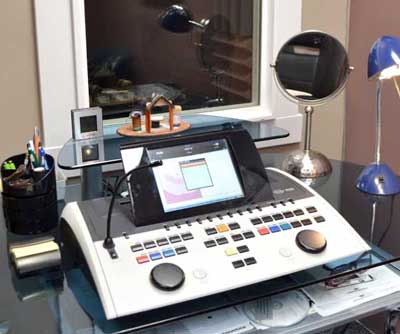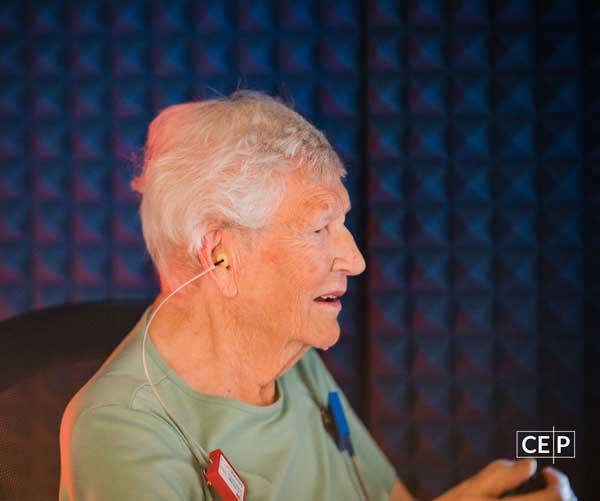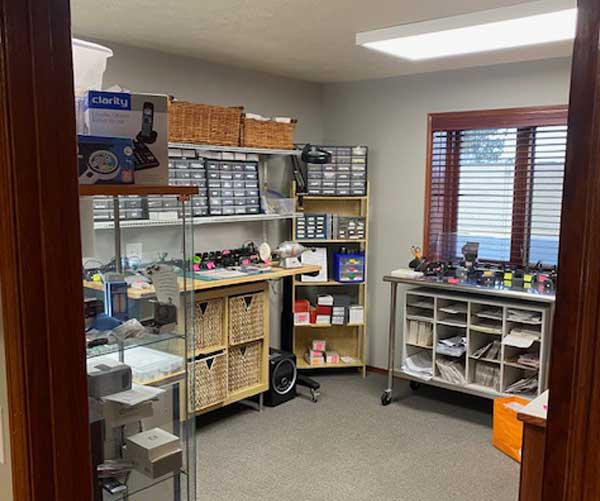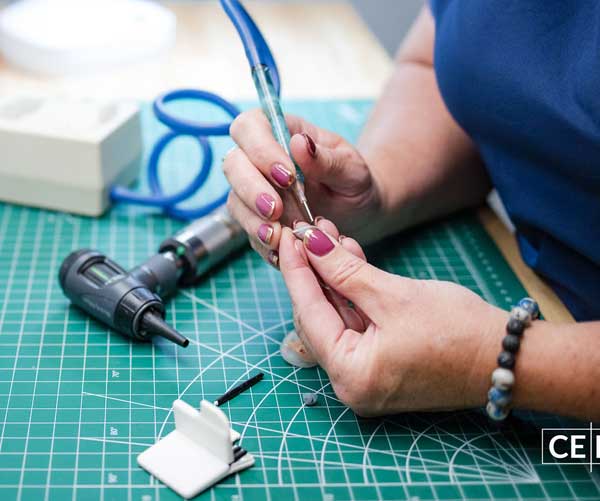Hearing Aids
Choosing the appropriate hearing aids is the beginning of your hearing healthcare journey. Hearing devices are an investment in your health. Today’s hearing aids use nanotechnology to deliver more precise and natural hearing results for patients. They are smaller, more powerful, more flexible, and produce better sound than ever before.
Western Hearing Aid Center offers a variety of hearing solutions to fit both your lifestyle and financial needs. If you are considering your options—or you’ve been thinking about upgrading your hearing aids—we encourage you to check out the newest hearing technology for yourself. You can choose from a number of different styles, ranging from hearing aids that fit completely in the ear canal to those that rest on top of or behind the ear.
Whatever your choice, you’ll be able to enjoy the wonderful sounds you’ve been missing.
Hearing Aids Styles

Invisible In-The-Canal (IIC)

Completely-in-the-Canal (CIC)
As one of the smallest custom-fit styles, CIC hearing aids sit deeply and entirely within the ear canal. Designed for mild to moderate hearing loss, they provide a discreet solution with high cosmetic appeal, as they are nearly invisible when worn.

In-the-Canal (ITC)
ITC hearing aids sit comfortably in the lower portion of the outer ear bowl, making them easy to use. Slightly larger than CIC models, they offer a longer battery life and can include additional features such as directional microphones for improved speech understanding in noisy environments, as well as volume controls. Designed for mild to moderate hearing loss, ITC devices provide a balance of discretion and functionality.

Full Shell or In-the-Ear (ITE)
Full shell ITE hearing aids sit securely within the outer ear bowl, providing a comfortable fit and enhanced functionality. Their larger size accommodates additional controls and features, such as directional microphones for improved speech clarity in noisy environments. They use a larger battery for extended power and can support a high-powered receiver, making them suitable for mild to severe hearing loss. With their versatility and advanced capabilities, full shell models are a widely recommended solution.
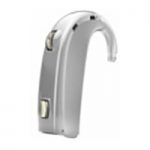
Behind-the-Ear Styles
Behind-the-Ear (BTE) hearing aids rest behind or on top of the outer ear, with tubing that directs sound into the ear canal via an ear tip or earmold. Available in a variety of colors—including subtle tones to match hair or skin, as well as bold options like chrome, leopard print, and other stylish designs—BTEs cater to both discretion and personal expression. Different BTE sizes offer varying levels of power, features, controls, and battery types, with larger models providing greater amplification. While some prefer nearly invisible BTEs, others embrace their unique designs as a fashion statement.

Mini BTE with Slim Tube and Tip
Mini BTE hearing aids are designed for discreet placement behind the outer ear, featuring ultra-thin tubing that delivers sound into the ear canal. The tubing connects to a soft tip that sits comfortably in the ear without fully blocking it, allowing natural airflow and sound to enter alongside the amplified sound. This “open fitting” design creates a more natural listening experience and is particularly recommended for individuals with mild to moderate high-frequency hearing loss.

Receiver in the ear (RITE)
RITE, also known as RIC (Receiver-in-Canal), models are a type of mini BTE hearing aid with the speaker (receiver) placed inside the ear tip rather than in the main body of the device. This design provides a more natural sound experience and allows for a smaller, more discreet casing behind the ear. RITE hearing aids are suitable for mild to severe hearing loss and closely resemble Mini BTE models when worn, offering both functionality and aesthetic appeal.

BTE with Earmold
BTE hearing aids with earmolds are designed to accommodate mild to profound hearing loss. Their longer shape contours behind the outer ear, providing space for advanced features such as program buttons and volume controls. The appearance of BTEs with earmolds varies based on the color and style of the earmold, as well as the wearer’s hairstyle, allowing for both discreet and personalized looks. This style offers a secure fit and powerful amplification, making it a versatile choice for a wide range of hearing needs.

Behind the Ear (BTE)
These are among the most common and traditional hearing aid style. This device rests behind or on top of your outer ear. A custom earmold secures the transparent rubber tube to the ear. The tube feeds amplified sound from the device’s speaker directly to the ear canal.

In the Canal Hearing Aid (ITC)
This is a custom made discrete hearing aid. Because it is made to fit the ear, it is easy to insert and comfortable to wear. Most incorporate advanced features like wireless Bluetooth streaming, directional microphones, and remote control, unlike some of the smaller CIC and IIC models. It can also accommodate a larger battery for longer battery life.

Completely in the Canal Hearing Aid (CIC)
This hearing aide provides an excellent nearly invisible option. This hearing aid is powerful enough for severe hearing loss and many are able accommodate a wireless antenna allowing for Bluetooth streaming and remote control function. With the smaller size does come a smaller battery and no room for directional microphones, which means that noisy environments may be more difficult.

Invisible in the Canal Hearing Aids (IIC)
This hearing aid fits deep in the ear canal, mere millimeters from the eardrum allowing for for crisp, clear, natural sound quality with less amplifier output, meaning better battery life. Its’ small size does not allow for a large battery or controls. IIC hearing aids need to be automatic because you can’t adjust them, which means they are only available in higher end circuitry. When the ear canal is large enough, IIC hearing aids can be made with a wireless antenna for remote control or Bluetooth integration.

In the Ear Hearing Aids (IIC)
This hearing aid offers flexibility that other hearing aids do not, a larger sound amplifier, direct access to handle and control your sound and most in-the-ear (ITE) hearing aids include a telephone switch and directional microphone.
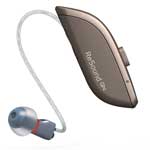
Microphone & Receiver-In-Ear
GN ReSound introduces the world’s first full-featured hearing aid with M&RIE (Microphone & Receiver-In-Ear) for a truly individualized, more complete sound experience. It uses your own ears to deliver sound.

Receiver In the Ear Hearing Aids (IIC)
Western Hearing Aid Center
Monday – Thursday: 9am-5pm
House calls on Friday.
Confidential appointments are available.
Western Hearing Aid Center accepts most insurance plans, including Workers’ Comp. Call us today for more details!
WE CARRY THE LATEST TECHNOLOGY FROM BRANDS YOU TRUST


